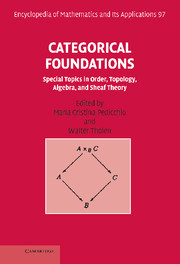Book contents
- Frontmatter
- Summary of Contents
- Preface
- Contents
- Introduction
- I Ordered Sets via Adjunction
- II Locales
- III A Functional Approach to General Topology
- IV Regular, Protomodular, and Abelian Categories
- V Aspects of Monads
- VI Algebraic Categories
- VII Sheaf Theory
- VIII Beyond Barr Exactness: Effective Descent Morphisms
- Index
V - Aspects of Monads
Published online by Cambridge University Press: 05 November 2013
- Frontmatter
- Summary of Contents
- Preface
- Contents
- Introduction
- I Ordered Sets via Adjunction
- II Locales
- III A Functional Approach to General Topology
- IV Regular, Protomodular, and Abelian Categories
- V Aspects of Monads
- VI Algebraic Categories
- VII Sheaf Theory
- VIII Beyond Barr Exactness: Effective Descent Morphisms
- Index
Summary
The objective of this chapter is to give the reader an understanding of monads and their associated algebraic structures, as well as some of their applications.
Monads first arose explicitly in homological algebra in the late 1950s and early 1960s. Comonads, i.e. monads in the dual of a category, first appear in Godement [15] who used the flabby sheaf comonad for resolving sheaves to compute sheaf co-homology. These structures were formalized and then applied to homotopy theory and homology theory by Huber, Barr, and Beck in [17, 4, 8]. In fact the history of the subject has been closely connected with applications. The applications to algebraic structures were initiated by the description of the algebras for a monad by Eilenberg and Moore [14] and closely related work of Kleisli [19].
Those mathematical structures which can be defined using only operations and equations have always attracted the mathematicians by their beauty, simplicity and wide range of applications. The first published proof that monads capture equational classes of algebras is the isomorphism theorem of Linton [23], extending Lawvere's description of algebraic theories [21]. Beck realized that monads describe universal algebra in the category of sets and proved his famous monadicity theorem [8].
Information
- Type
- Chapter
- Information
- Categorical FoundationsSpecial Topics in Order, Topology, Algebra, and Sheaf Theory, pp. 213 - 268Publisher: Cambridge University PressPrint publication year: 2003
Accessibility standard: Unknown
Why this information is here
This section outlines the accessibility features of this content - including support for screen readers, full keyboard navigation and high-contrast display options. This may not be relevant for you.Accessibility Information
- 11
- Cited by
